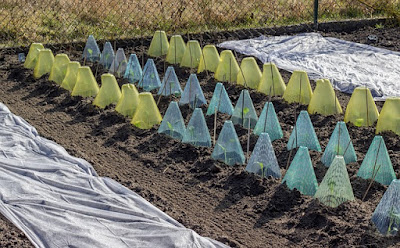We know the routine. Working through the seasons addressing immediate needs, we are often caught by surprising weather forecasts.
OMG! It’s gonna drop tonight into the teens or below! Better cover those tender plants, but with what?
Winter is coming. It always does. Don’t let frigid weather catch your garden unprepared. Get ready now.
There are lots of methods for protecting your garden from deep freezes. Here are a few:
Cloches. Garden cloches are bell- or cone-shaped covers that are placed over individual plants for frost protection. Cloches of yesteryear were made of clear glass. Most are now made of materials such as plastic, or frames covered with light-weight plastic sheeting, polypropylene or polyester fabric. The fabrics trap heat while still allowing light and moisture to pass through. Unless they have devices for allowing heat to escape, those of solid materials must be removed before too much heat builds up.
Frost fabrics. Frost fabrics are those light-weight materials as mentioned above for cloches, but purchased in much larger sheets. They work the same way and should be suspended over your plants, avoiding contact with foliage. This is often accomplished by draping the material over hoops or rods and anchoring the sides and ends to the garden soil or sides of raised beds to prevent the fabric from blowing off. These work fine unless a load of snow is forecast. In that case, the structures should have sloping sides to allow snow to slide off.
Greenhouses. These are commercially available in a wide range of sizes, materials and costs, or they can be homemade. You’ll find a host of videos on YouTube and other media sites to assist you with planning and completion.
Straw mulch. Mother Nature is hard to beat. Straw mulch can be laid around your plants – even over some of them – for protection. Mulch traps heat from the soil just as synthetic materials do. When winter is over and spring has sprung, the mulch can be raked aside and allowed to decompose in the garden, helping to retain moisture and enhancing soil fertility.
So, plan now to protect your garden from frigid weather. Gather your materials now and have them ready for use before that fateful weather forecast is announced.
Return to GoGardenNow.com.






